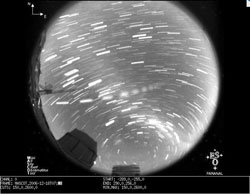It Is Too Early To Be Santa's Sleigh, Isn't It?

An unusual object was found on ESO Paranal MASCOT images in the morning of 18 December 2006. The whole sequence, seen above, shows how the object then takes the shape of a cloud that vanishes.
Astronomers at ESO's frontline Paranal Observatory got a surprise on the morning of 18 December when looking at the observatory's all-sky camera, MASCOT. For about 45 minutes in the early morning, an object appeared first as a bright stripe then as a cloud that dissolved.
The discovery was made a little after 4 o'clock in the morning (7:00 GMT) by Christian Esparza, the operator of Antu, the first Unit Telescope (UT1) of ESO's Very Large Telescope who showed it to ESO astronomer Thomas Rivinius. Looking at the Mini All-Sky Cloud Observation Tool (MASCOT [1]), Esparza was surprised by the presence of a nebular object.
“I went outside to make sure this was not an optical effect,” said Rivinius. “At the time I saw it, it had already taken the appearance of a cloud. In fact, it was as large and as bright as the Large Magellanic Cloud.”
Having been convinced this was no fault on the camera, the astronomers went on a real detective chase to try to find out what the object could be. ESO's comet specialist Emmanuel Jehin quickly established that it could not be a meteor nor a comet. It was moving too slowly for a meteor – a meteor is seen for example on one of the images (see ESO PR Photo 48b/06) as a tenuous and fleeting streak – or for the International Space Station. Moreover, no other known satellite was supposed to pass above Cerro Paranal, in the Atacama Desert at that time. And why would the ISS or a satellite suddenly change shape from a bright point to a cloud?
Checking the Night Sky Live web site, the astronomers then found out that the same phenomenon had been observed with the all-sky camera located at the site of Gemini South at Cerro Pachon, also in Chile and 600 km south of Paranal. Using these observations and a simple triangulation technique used, for example, in land surveys, it was then possible to measure the distance of the object. It appeared that the object was about 6000 km high when first seen and about double that in the later images. The object was moving away from Earth at tremendous speed!
Given this close distance, an astronomical object seemed unlikely and the only remaining possibility left to the scientists was to consider if a rocket had been launched. And, eureka!, it was quickly discovered that the same morning, about one hour before the object was seen from Paranal, the Japanese Aerospace Exploration Agency (JAXA) had launched a H-IIA rocket carrying the KIKU No. 8 (ETS-VIII) engineering test satellite, one of the largest geostationary satellites in the world.
The launch took place from the Tanegashima Space Center at 3:32 p.m. on December 18, 2006, Japan Standard Time (that is 3:32 a.m. Chilean time or 6:32 a.m. GMT). The launch vehicle flew smoothly, and, at 27 minutes and 35 seconds after lift-off, the KIKU No. 8 separation was confirmed. The Santiago station (in Chile) started receiving signals from the KIKU No. 8 at 4:27 a.m. Chilean Time.
Finally the mystery was solved: the object was most probably the 2nd stage of the launcher and the cloudy appearance at the end of the sequence most likely a dump of liquid fuel, made to avoid the explosion of the rocket in hundreds of scattered pieces, as a result of leftover fuel inside spent rocket stages. Having cracked the problem with his colleagues, Thomas Rivinius could finally go to sleep!
Note
[1]: MASCOT is the All-Sky Monitor of the Paranal Observatory. It delivers, every three minutes, images of the complete night-time sky, mainly to allow the detection of clouds.
Media Contact
More Information:
http://www.eso.org/outreach/press-rel/pr-2006/pr-48-06.htmlAll latest news from the category: Physics and Astronomy
This area deals with the fundamental laws and building blocks of nature and how they interact, the properties and the behavior of matter, and research into space and time and their structures.
innovations-report provides in-depth reports and articles on subjects such as astrophysics, laser technologies, nuclear, quantum, particle and solid-state physics, nanotechnologies, planetary research and findings (Mars, Venus) and developments related to the Hubble Telescope.
Newest articles

Silicon Carbide Innovation Alliance to drive industrial-scale semiconductor work
Known for its ability to withstand extreme environments and high voltages, silicon carbide (SiC) is a semiconducting material made up of silicon and carbon atoms arranged into crystals that is…

New SPECT/CT technique shows impressive biomarker identification
…offers increased access for prostate cancer patients. A novel SPECT/CT acquisition method can accurately detect radiopharmaceutical biodistribution in a convenient manner for prostate cancer patients, opening the door for more…

How 3D printers can give robots a soft touch
Soft skin coverings and touch sensors have emerged as a promising feature for robots that are both safer and more intuitive for human interaction, but they are expensive and difficult…





















